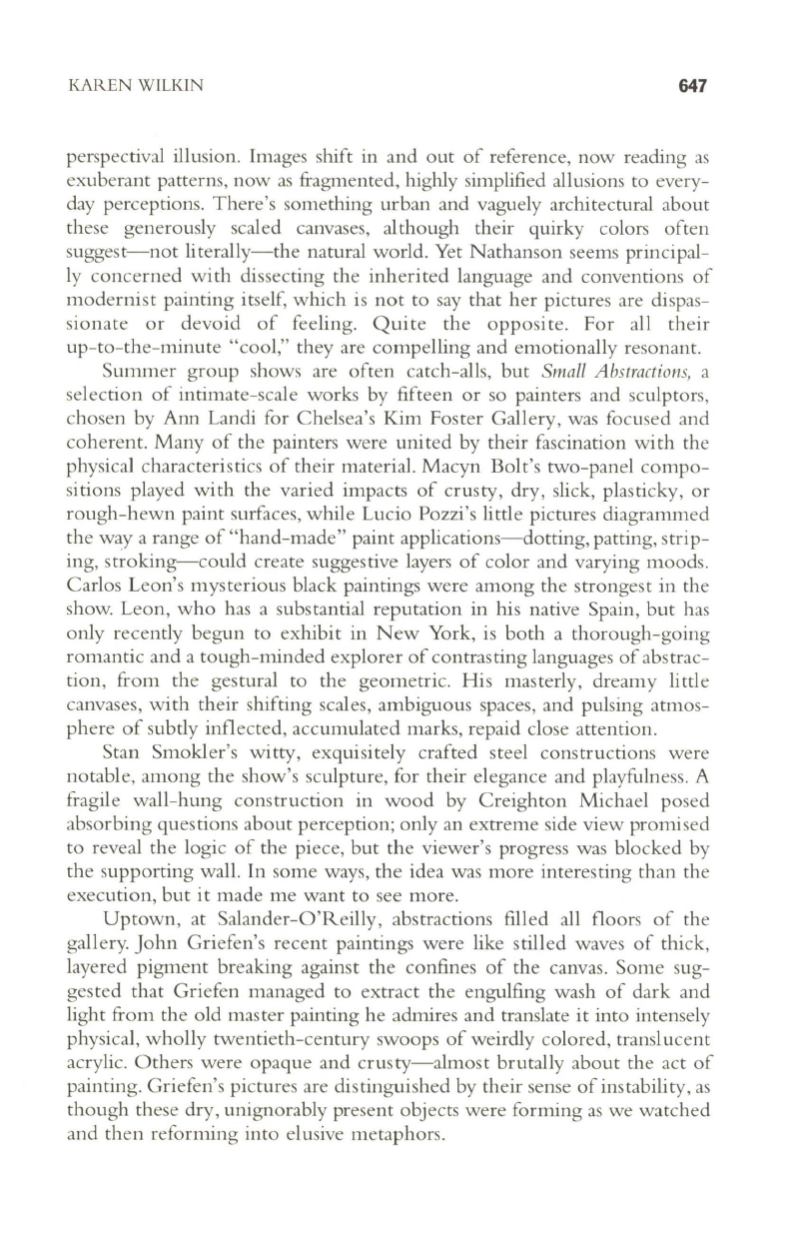
KAREN WILKIN
647
perspectival illusion. Images shift in and out of reference, now reading as
exuberant patterns, now as fragmented, highly simplified allusions to every–
day perceptions. There's something urban and vaguely architectural about
these generously scaled canvases, although their quirky colors often
suggest-not literally-the natural world. Yet Nathanson seems principal–
ly concerned with dissecting the inherited language and conventions of
modernist painting itself, which is not to say that her pictures are dispas–
sionate or devoid of feeling. Quite the opposite. For all their
up-to-the-minute "cool," they are compelling and emotionally resonant.
Summer group shows are often catch-alls, but
Small Abstractions,
a
selection of intimate-scale works by fifteen or so painters and sculptors,
chosen by Ann Landi for Chelsea's Kim Foster Gallery, was focused and
coherent. Many of the painters were united by their fascination with the
physical characteristics of their material. Macyn Bolt's two-panel compo–
si tions played wi th the varied impacts of crus ty, dry, slick, plas ticky, or
rough-hewn paint surfaces, while Lucio Pozzi's little pictures diagrammed
the way a range of "hand-made" paint applications-dotting, patting, stri p–
ing,
st~oking-could
create suggestive layers of color and varying moods.
Carlos Leon's mysterious black paintings were among the strongest in the
show. Leon, who has a substantial reputation in his native Spain, but has
only recently begun to exhibit in New York, is both a thorough-going
romantic and a tough-minded explorer of contrasting languages of abstrac–
tion, from the gestural to the geometric. His masterly, dreamy little
canvases, with their shifting scales, ambiguous spaces, and pulsing atmos–
phere of subtly inflected, accumulated marks, repaid close attention.
Stan Smokler's witty, exquisitely crafted steel constructions were
notable, among the show's sculpture, for their elegance and playfulness. A
fragile wall-hung construction in wood by Creighton Michael posed
absorbing questions about perception; only an extreme side view promised
to reveal the logic of the piece, but the viewer's progress was blocked by
the supporting wall.
In
some ways, the idea was more interesting than the
execution, but it made me want to see more.
Uptown, at Salander-O'Reilly, abstractions filled all floors of the
gallery. John Griefen's recent paintings were like stilled waves of thick,
layered pigment breaking against the confines of the canvas. Some sug–
gested that Griefen managed to extract the engulfing wash of dark and
light from the old master painting he admires and translate it into intensely
physical, wholly twentieth-century swoops of weirdly colored, translucent
acrylic. Others were opaque and crusty-almost brutally about the act of
painting. Griefen's pictures are distinguished by their sense of instability, as
though these dry, unignorably present objects were forming as we watched
and then reforming into elusive metaphors.


